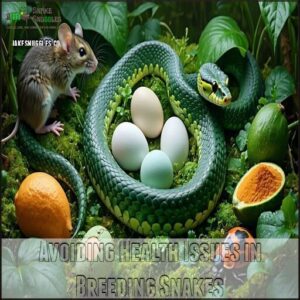This site is supported by our readers. We may earn a commission, at no cost to you, if you purchase through links.

Increase feeding frequency for females before breeding and after egg-laying. Offer appropriately-sized rodents (mice, rats) that are about 1-1.5 times the width of your snake’s midsection.
For most species, you’ll want to supplement with calcium for females, who need extra nutrients during egg production. Keep fresh water available at all times, and consider adding variety with quail, chicks, or rabbits for larger species.
Proper nutrition during breeding isn’t just food—it’s the foundation for those perfect little hatchlings slithering into the world, and it requires careful consideration of the snake’s overall dietary needs, including the importance of proper nutrition.
Table Of Contents
Key Takeaways
- You’ll need to increase feeding frequency for female snakes before breeding and after egg-laying, offering prey items that are 1-1.5 times the width of your snake’s midsection.
- Your breeding snakes require calcium supplementation, especially females during egg production, to prevent metabolic bone disease and support healthy offspring development.
- You should maintain proper hydration with clean water bowls large enough for soaking, while monitoring species-specific humidity levels which directly impact successful breeding and egg development.
- You can diversify your snake’s diet with appropriately-sized whole prey including mice, rats, quail, chicks, or rabbits, ensuring complete nutrition without the need for many additional supplements.
Feeding Breeding Snakes
You’ll need to adjust your breeding snake’s diet to support egg production and guarantee healthy offspring.
Proper nutrition during this critical time means increasing feeding frequency and offering nutrient-rich whole prey items that provide the extra calories and nutrients your snake needs to support healthy offspring.
Nutrition Requirements
When considering breeding snakes, proper nutrition forms the foundation for successful reproduction.
Your breeding snake’s diet must meet specific nutritional requirements to support egg production and healthy offspring.
For ideal breeding success:
- Verify adequate dietary fat content (15-20%)
- Provide sufficient calcium for egg development
- Maintain proper hydration through prey and fresh water
- Match feeding frequency to breeding energy demands
Don’t underestimate how nutrition directly impacts fertility and hatchling quality.
Prey Items for Breeding Snakes
Your breeding snake’s diet directly impacts offspring health.
Whole prey items like mice, rats, and quail form the foundation of a nutritious breeding snake diet.
For peak snake egg production, rotate between rodent variety and bird alternatives such as chicks and quail eggs.
While fish can provide enrichment, they pose risks unless carefully sourced.
Ethical sourcing of prey guarantees you’re providing quality nutrition without supporting inhumane practices.
To guarantee safety, consider the risks of live prey, ensuring quality nutrition and safe feeding practices.
Feeding Frequency and Quantity
After choosing the right prey items, you’ll need to adjust your feeding frequency and quantity.
During the pre-breeding increase phase, feed females more frequently—about every 5-7 days. Males need consistent feeding but not overfeeding.
Once eggs are laid, implement a post-laying reduction in feeding. Watch for natural fasting periods, which often indicate reproductive activity.
Prey size should match your snake’s girth, and remember there’s significant individual variation in appetite during breeding cycles.
What to Feed Breeding Snakes
The ideal diet for breeding snakes requires careful consideration to guarantee reproductive success.
When preparing your snake for breeding, focus on high-quality prey items that support egg production and overall health.
Rodents remain the cornerstone of breeding snake nutrition, but strategic gut-loading of prey with calcium-rich foods enhances calcium supplementation vital for egg development.
You’ll want to increase feeding frequency as females approach breeding season—their bodies need extra resources for producing healthy offspring.
Diversify the diet with appropriately-sized prey: mice and rats for most species, while larger pythons may benefit from small rabbits or birds.
Post-laying diet is equally important; females need nutritional recovery after the energy-intensive process of egg production.
For hatchling nutrition, properly-sized prey ensures they start life strong.
Remember that healthy snake diet translates directly to breeding snake health, making consistent, quality nutrition your most powerful tool in successful reptile breeding nutrition, which is crucial for reproductive success and supports the overall breeding process with high-quality prey and proper egg production.
Snake Diet and Nutrition
You’ll need to provide your breeding snakes with whole-prey nutrition that includes essential vitamins and varied food sources to support successful reproduction.
Properly fed parent snakes produce healthier offspring, so understanding their nutritional needs isn’t just about keeping them alive—it’s about helping them thrive during the demanding breeding process, which is crucial for successful reproduction.
Whole Prey Feeding
When selecting snake breeding food, whole prey offers perfect nutritional completeness without added supplements.
You’ll want to match prey size to your snake’s girth – typically 1-1.5 times their mid-body width.
Frozen prey is safer than live options, eliminating injury risks while supporting ethical sourcing practices.
Your breeding snakes will benefit from complete nutritional balance as they digest everything – bones, organs, and fur – just as nature intended for ideal reptile breeding nutrition.
Vitamin and Mineral Supplements
While whole prey typically provides complete nutrition for snakes, breeding females may need additional supplements to support egg development.
Breeding females thrive with whole prey but may need supplements to bridge nutritional gaps and ensure healthy egg development.
Vitamin and mineral supplements can help bridge nutritional gaps during this demanding time.
- Calcium supplements – essential for preventing metabolic bone disease in females depleted from egg production
- Vitamin D3 boosters – critical for calcium absorption and healthy offspring development
- Multivitamins – support overall reproductive health when used sparingly
For specialized needs, consider reptile supplement options.
Remember, over-supplementation poses serious risks, so follow dosage guidelines carefully.
Prey Item Variety for Breeding Snakes
Beyond supplements, your breeding snake’s nutritional needs benefit from prey variety.
Try rodent alternatives like African soft fur rats or degus with lower body fat than mice.
Bird inclusion (quail, chicks) mimics natural feeding behaviors and provides different nutrients.
Consider Reptilinks for convenient options including rabbit and frog without filling your freezer.
Egg benefits include easy-to-source quail eggs that many corn and rat snakes readily accept.
Always prioritize ethical sourcing for your snake breeding diet, ensuring a well-rounded approach to nutritional needs.
Breeding Snake Feeding Schedule
You’ll need to adjust your feeding schedule as your snake enters breeding season, increasing meal frequency for females and monitoring appetite changes closely.
During this critical time, female snakes require additional nutrients to develop healthy eggs or offspring, while males may temporarily reduce their food intake due to breeding behaviors.
Female snakes require additional nutrients to develop healthy eggs or offspring.
Feeding Frequency by Age and Size
While your snake’s size largely determines its feeding schedule, age plays an equally important role in determining proper portions.
Hatchlings require small meals twice weekly, juveniles need appropriately sized prey every 5-7 days, and adults do well with larger meals every 1-4 weeks.
Your snake feeding guide should avoid power feeding, which can lead to obese snakes. Female breeders might need more frequent meals than their male counterparts.
To guarantee proper growth, consider that prey size matters.
Feeding During Breeding Season
Many female snakes require dietary adjustments during breeding season to support egg production.
You’ll need to provide increased calories before mating, while being prepared for potential fasting periods as breeding progresses.
- Offer slightly larger prey items for extra calcium supplementation
- Feed females more frequently until they naturally begin fasting
- Respect fasting periods, which often indicate successful fertilization
- Resume normal feeding schedule after egg-laying
- Focus on post-laying nutrition to help females recover their strength
Monitoring Snake Health and Appetite
Keep your eyes peeled for appetite changes in breeding snakes, as they often signal health issues.
You’ll need to monitor weight regularly, check hydration status, and watch for shedding problems.
Record feeding responses and examine fecal matter for abnormalities.
During breeding season, females might stop eating entirely—this can be normal, but prolonged fasting requires veterinary attention.
As snakes age, feeding frequency changes.
Trust your instincts; you know your snake’s typical behavior best, and be aware of health issues.
Water and Humidity for Breeding Snakes
You’ll need to provide your breeding snakes with fresh, clean water at all times in a spill-proof dish that’s large enough for soaking, which supports proper hydration and successful reproduction.
Maintaining the right humidity levels in your snake’s enclosure is equally important, as it directly affects breeding success, proper shedding, and the overall health of your breeding snakes and their offspring, ensuring successful reproduction.
Water Bowl Size and Cleaning
Choosing the right water bowl for breeding snakes isn’t just about hydration—it’s essential for their reproductive health.
Your water bowl should be heavy enough to prevent tipping, large enough for soaking (especially for gravid females), and made of non-porous material.
Clean and disinfect bowls daily using reptile-safe products to prevent bacterial growth.
For snake breeding success, use dechlorinated water and position bowls away from heat sources.
Many keepers opt for a durable feeding container to prevent spills.
Maintaining Optimal Humidity Levels
Beyond keeping water bowls clean, proper humidity levels directly impact your snake’s breeding success. Maintaining ideal humidity creates an environment where your breeding snakes can thrive.
- Your snake’s perfect shed is a beautiful sight that signals good hydration balance
- Watching eggs develop properly feels incredibly rewarding after months of careful preparation
- Nothing beats the relief of hearing clear breathing without respiratory issues
- The pride in mastering environmental control rivals any breeding achievement
- That moment when perfect humidity results in successful hatching is worth every effort
For snake breeding success, monitor humidity daily using a quality hygrometer. Maintaining accurate readings requires a reliable monitoring device. Different species require specific levels—ball pythons need 50-60% humidity, while tropical species may need 70-80%. During shedding and egg development, slightly increase humidity to support healthy reproduction and prevent dehydration issues, ensuring a healthy environment for your snakes, which is crucial for their well-being and successful hatching, and ultimately leads to proper hydration and good hydration balance.
Preventing Dehydration in Breeding Snakes
While humidity sets the stage, water availability directly impacts snake hydration during breeding.
You’ll notice increased soaking behavior as breeding snakes require more water than usual. Place a large, stable snake water bowl that won’t tip when your snake climbs in.
Watch for shedding difficulties, which signal dehydration. Proper water and humidity work together to maintain electrolyte balance, preventing health issues that could derail successful snake breeding.
Clean water is essential, as hygiene prevents parasite growth, to ensure successful snake breeding and prevent issues related to poor hygiene.
Avoiding Health Issues in Breeding Snakes
You’ll prevent most health complications in your breeding snakes by establishing proper feeding routines with nutritionally complete prey items.
Maintaining consistent feeding schedules and carefully monitoring your snake’s appetite can help you quickly identify potential issues before they develop into serious conditions, which involves complete concepts and carefully monitoring.
Recognizing Signs of Anorexia
When your breeding snake refuses food for more than two feedings, you’re likely witnessing early signs of anorexia.
Watch for weight loss, lethargy signs, regurgitation, and behavior changes.
Healthy snakes show immediate food response, while snakes with anorexia exhibit complete food refusal.
Environmental stressors, improper temperatures, or breeding season can trigger snake appetite issues.
Monitor closely—what appears as normal fasting might actually indicate a serious health concern.
Common Health Issues in Breeding Snakes
While monitoring your breeding snakes for appetite changes, you’ll need to watch for common health issues too.
Respiratory infections often result from improper husbandry, while shedding problems typically stem from low humidity.
Stomatitis (mouth rot) appears as swelling and unusual breathing patterns.
Your breeding program can face challenges from egg binding, dystocia causes, and prolapse issues.
Genetic disorders and metabolic disease may also impact reproductive success.
Regular health checks will keep your snake nutrition program on track.
In addition, be vigilant for signs of snake skin problems, which can indicate underlying health concerns.
Preventing Parasites and Infections in Breeding Snakes
To fend off parasites and infections in breeding snakes, implement strict quarantine protocols for new additions.
Always practice thorough hygiene practices by disinfecting handling tools and enclosures regularly. Source prey items from reliable suppliers who prioritize safety.
Consider proactive screening twice yearly to catch potential issues early. If problems arise, consult a reptile veterinarian about medication options.
Remember, prevention is easier than treatment when managing the nutritional needs of breeding snakes.
Frequently Asked Questions (FAQs)
How to handle fasting during breeding cycles?
When your snake starts fasting during breeding cycles, don’t panic.
Continue offering food for a few weeks after they stop eating.
Monitor their weight and behavior closely, as fasting often indicates successful fertilization.
Can I supplement with non-rodent prey items?
Yes, you can diversify your snake’s diet with birds, eggs, and fish.
Quail eggs and frozen chicks from reputable suppliers work well.
Just avoid amphibians and make certain fish are parasite-free and thiaminase-free.
When should I separate breeding pairs?
You’ll need to separate breeding pairs immediately after successful mating to prevent stress and potential aggression.
Watch for signs they’ve completed mating, then return each snake to their individual enclosures for safety.
Should feeding practices differ by snake species?
Like finding the right key for each lock, you’ll need to tailor feeding practices to your specific snake species.
Different species have unique nutritional requirements, feeding frequencies, and prey size preferences, which makes understanding these unique nutritional requirements crucial for the well-being of your snake.
How to ethically source diverse prey items?
To ethically source diverse prey items, purchase from reputable breeders who humanely euthanize animals.
You’ll find frozen rodents, chicks, and quail eggs at specialty reptile suppliers.
Avoid wild-caught prey that might carry parasites.
Conclusion
Picture those healthy hatchlings slithering around, thriving because you’ve mastered what to feed breeding snakes.
You’ll see remarkable results when you provide calcium-dusted rodents, varied prey items, and adjust feeding schedules to support reproduction.
Remember, proper hydration works alongside nutrition to guarantee successful breeding cycles.
By prioritizing high-quality food sources and monitoring your snake’s condition, you’re setting up both parents and offspring for vibrant, healthy lives in captivity.













